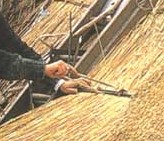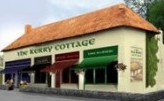Ag Caint faoi Thuí agus faoi Thuíodóireacht (Speaking of Thatching) Posted by róislín on Apr 14, 2013 in Irish Language
(le Róislín)
Before moving away from tuíodóireacht to other topics, I thought it would be interesting to look at the tools used by a tuíodóir, and also to look briefly at the use of díonta tuí outside of Ireland and Britain.
You might have just noticed the phrase “díonta tuí” (thatched roofs). And you might also remember that the typical phrase for a “thatch-roofed cottage” is “teach beag ceann tuí,” using “ceann” instead of “díon” for roof. “Díon” (plural: díonta) appears more often when discussing thatched roofs as a roofing style and “ceann tuí” or its plural “cinn tuí” appears more often when describing the roofs of specific cottages. At any rate, “díon” is the standard word for “roof.” As you may recall, “ceann” normally means “head.” Whichever term is used, the array of traditional tools used for tuíodóireacht is quite fascinating.
Two of the thatching tools caught my eye because their names in English are so unusual, “spurtle” and “leggat.” As you’ll see below, the Irish terms are more self-explanatory.
spurtle: sáiteoir, pl. sáiteoirí. In Irish, this literally means a “thruster” or “pusher.” The word “sáiteoir” is also used in engineering terminology, as in “sáiteoir pilí” (a pile-driver). A “sáiteoir muc” is, as you may have guessed, a “pigsticker,” and more benignly, a “sáiteoir cuaillí” is a “pole-sinker.” A “sáiteoir” can also mean a “meddler” or “intruder,” not too different from a “sáiteachán” (nagging person). They’re all based on the verb “sáigh” (push, press, prod, stab, and, figuratively, nag, etc.).
In the thatched-roof context, the spurtle is an elongated tool with a smallish prong at one end, used for patching.
leggat or leggatt: cíor thuí (lit. a thatch-comb). “Cíor” is the ordinary word for a “comb” (cíor mhín, fine-toothed comb; cíor gharbh, large-toothed comb; cíor chapaill, a curry-comb, etc.). “Tuí” is lenited here because it is used as an adjective, and in this case, happens to modify a feminine noun (cíor, comb; an chíor, the comb). “Cíor” is also a verb, with “cíoradh” as the verbal noun. It can mean “to comb” literally (capall a chíoradh, to curry a horse; olann a chíoradh, to comb wool), but, like “sáigh,” it has its share of figurative meanings, such as “ag cíoradh ceiste” (examining a question minutely), “ag cíoradh na gcomharsan” (backbiting the neighbors, i.e. combing through their idiosyncrasies), and “ag cíoradh a chéile,” which might sound like some nice co-grooming/bonding activity but actually means “fighting” or “quarrelling.”
Come to think of it, though, nit-picking (piocadh na sneá?) really is a positive activity (as mutual grooming), isn’t it? At least that’s the case when it’s practiced by babúin, meacaicí, and other animals — by participating in the system of grúmaeireacht shóisialta or comhghrúmaeireacht, you reinforce your place in the community. As you groom, so shall you be groomed? You may also get some other benefits best left to the “samhlaíocht” (imagination).
Some of the other thatching tools, with more ordinary names (sa Bhéarla agus sa Ghaeilge) are:
knife: scian [SHKEE-un], pl: sceana [SHKAN-uh]
thatching needle: snáthaid tuíodóireachta, pl: snáthaidí tuíodóireachta. Even though “snáthaid” [SNAW-hidj] is feminine, there’s no lenition following it because of the d-n-t-l-s rule. So “tuíodóireachta,” here functioning like an adjective, retains the ordinary initial “t” instead of changing to “th.” In contrast, consider “snáthaid chléithe” (with lenition of “cléithe“) but “snáthaid dearnála” (with no lenition because of the d-n-t-l-s rule). “Snáthaid chléithe” and “snáthaid dearnála” both mean the same thing, a “darning needle.” “Snáthaid” is the general word for “needle” (sewing, etc.), but, always a vocabulary caveat, knitting needles are “bioráin” or “dealgáin.” “The needle” (sewing, etc.) is the delightful-to-pronounce combo “an tsnáthaid” [un TNAW-hidj].
Thatchers also used knee-protectors. I haven’t found a specific Irish word for them, but assume it would be “cosantóirí glúine” (protectors of knee). Eolas ag duine ar bith eile?
scollop, rod, spar, squeeze-loop: scolb, pl: scoilb (as discussed in the previous blog and as in the well-known Irish proverb, “Ní hé lá na gaoithe lá na scolb.” Why does the proverb say “scolb” and not “scoilb” at the end when the implication is plural (“The windy day is not the day of the thatching spars”)? Because “scolb” (no “i”) is the genitive plural form for this masculine noun. “Scolb” serves both as the singular form for the subject or direct object (Tá an scolb déanta as adhmad / The thatching spar is made of wood; Rinne sé scolb as adhmad / He made a thatching spar out of wood) and as the plural form, when showing possession (however abstract), as in “lá na scolb” (once again, “the day of the scollops” or thatching spars).
Another interesting English word connected to thatching is “yolm,” with variations such as “yelm” and “yealm.” It means an armful or bundle of thatching material (straw, etc.) as laid out for the thatcher to use. “Yolm,” is documented from the Midlands of Ireland; the other spellings are mostly local to regions of England. “Fainneal” would appear to be the equivalent in Irish, but so far I haven’t found any sources that actually translate a “fainneal” as a “yolm, ” probably because “yolm” is more dialect than standard English (whatever “standard” English is these days!).
In England, the thatcher might work with a “yelmer” who prepared or laid out the material for the thatcher. I haven’t found any equivalent term for the “yelmer” in Irish, but that doesn’t mean there isn’t one. Eolas ag duine ar bith?
Other thatching tools and equipment included deimheas (shears), various types of hooks, and of course, for any roof work, an dréimire (the ladder), perhaps the most useful of all these terms for our general purposes today.
Speaking of dréimirí, that brings us to an ábhairín machnaimh. Thatched cottages didn’t have gutters as part of the roof, so the hours many suburban homeowners spend perched on dréimirí, ag glanadh na ngáitéar, would be avoided. And that sounds like a good thing!
If you’re considering a díon tuí in the U.S., or are simply interested in reading more about them, here’s a link to Commonwealth Roofing Corp., located in Louisville, KY, which includes thatched roofs among other styles they offer: http://commonwealthroofing.com/roof-types/thatched-roof/ . I could, of course, list their roof types in English, but where would the dúshlán be then? Here are some of them, in Irish: slinn, slinn adhmaid, “glas,” miotal, tíl, and “scannán.” Can you figure them out? Leid: “scannán” here isn’t translated the way you might expect, based on phrases like “Bord Scannán na hÉireann” (Film Board of Ireland) but instead we have here an older use of the word, dating back to laethe réamhdhigiteacha when films were actually made ar cheallalóid. Aistriúcháin thíos, sa nóta.
In Commonwealth Roofing’s picture gallery, I found an article about “The Kerry Cottage,” a thatched-roof Irish gift shop in Maplewood (St. Louis), Missouri, which was named after the ancestral homeland of the proprietor Maura Lawlor: http://www.kerrycottage.com/custom.aspx?id=1. Suimiúil!
And that opens up the discussion even more broadly. Are there any thatched-roof cottages or other buildings in your area? In Éirinn nó taobh amuigh d’Éirinn? If so, are they part of an open-air museum or a historic site, or are they actual residences? Ar mhaith leatsa a bheith i do chónaí i dteach beag ceann tuí, preferably one that is “in ascaill an ghleanna” (for full effect). Nó arbh fhearr leat fanacht i dteach mar sin ar feadh seachtaine, b’fhéidir, ar laethanta saoire? Either way, it’d be interesting to hear bhur mbarúlacha. SGF, Róislín
Nóta faoi chineálacha díonta (slinn, slinn adhmaid, “glas,” miotal, tíl, scannán): in order, these are slate, shingle, “green,” metal, tile, and membrane.

Build vocabulary, practice pronunciation, and more with Transparent Language Online. Available anytime, anywhere, on any device.






Comments:
Mike grimes:
Interesting article… such a pity that the majority of thatched cottages in Ireland are thatched with imported Turkish Reed. Is it because of the convoluted information that Irish reeds are no good and not suited for thatching Or that greedy reed importers (450,000 sheaves in 2019) claim that Irish Reeds are no good and not suited for thatching.